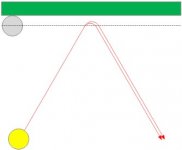Sorry, I gotta disagree with both of these...
1. It isn't the CB sinking into the cushion that shortens the rebound angle; it's rail/cloth friction holding its "parallel-to-the-rail" motion back.
2. That shortening friction only holds true if the CB is sliding (no forward or back spin) when it hits the rail. Otherwise its forward roll makes it masse "forward" after rebound, going longer/wider than the equal angle. Aiming at the diamond hits the rail a little short, as you say, but is the (approximate) correct aim for a normally rolling ball.
pj
chgo
It doesn't surprise me that you disagree.

Lol.
I'm speaking in the simplest terms possible when I say the cb sinks into the cushion and then departs at a smaller/tighter angle than its approach angle. That's what happens. No need to go into the frictional details to explain why this happens. Basically, the harder you hit it the shorter the rebound angle.
Shoot the cb with a medium or soft rolling speed from a corner pocket to the 2nd diamond on the long rail. On most tables the cb will scratch perfectly in the opposite side pocket. Shoot it a little firmer, still with a normal forward roll, and it'll come out short, might still hit the pocket, but more than likely hit the point of the side pocket facing. Now shoot the same kick again but hit it very firm with no spin. It will land very short of the side pocket. Now of course you could load it up with top, draw, inside or outside english, and manipulate this rebound angle all you want in accordance with what you need. At wider angles, even the example I used above, top spin doesn't immediately kick in. The cb comes off shorter first because it drives deeper into the cushion, then as it starts across the table it begins to bend forward. Hit it too hard and it might not bend forward enough before it hits the opposite rail. A lot of factors to consider.
Basically, PJ, I was simply describing (without any unnecessary details or going into all the factors) what generally happens to the outbound angle when the cb hits the cushion. :smile:
